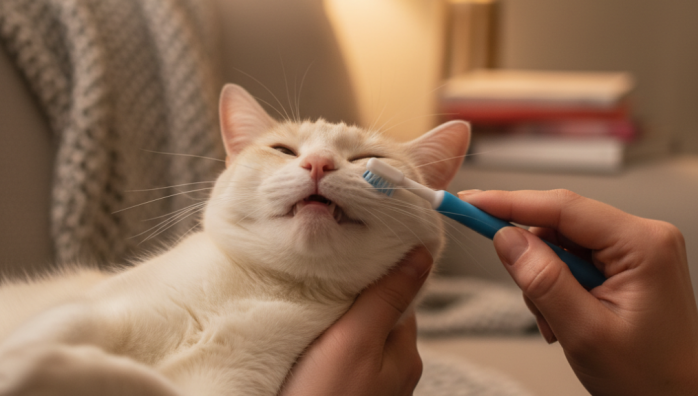Brushing Your Cat's Teeth Safely
by admin in Pet Care Basics 24 - Last Update November 20, 2025

I\'ll be honest, the first time a vet told me I should be brushing my cat\'s teeth, I probably laughed. The idea of getting a toothbrush anywhere near my fiercely independent cat, Leo, seemed like a recipe for disaster. For years, I put it off, relying on dental treats and wishful thinking. But after a costly dental cleaning under anesthesia, I knew I had to face my fears for his long-term health. It wasn\'t easy, but I\'ve since developed a slow, patient method that actually works, and I want to share what I\'ve learned.
Why this matters more than you think
Before we get into the \'how\', let\'s touch on the \'why\'. I learned the hard way that periodontal disease is incredibly common in cats and can lead to pain, tooth loss, and even systemic health issues affecting their heart and kidneys. Brushing is the gold standard for preventing the buildup of plaque and tartar. It\'s not just about \'cat breath\'; it\'s about their overall wellness and quality of life. Thinking of it this way truly motivated me to stick with the process.
Gathering your gentle toolkit
The right tools make all the difference. Rushing out and buying a random brush and paste was my first mistake. Here’s what I found works best:
- Feline-Specific Toothpaste: This is non-negotiable. Human toothpaste contains ingredients like fluoride and xylitol that are toxic to cats. I opt for an enzymatic poultry-flavored one, which Leo finds much more agreeable.
- A Soft-Bristled Brush: I started with a tiny, soft rubber finger brush. It felt less intrusive to him than a long-handled brush. As he got more comfortable, I graduated to a small-headed cat toothbrush with very soft bristles.
- Patience and High-Value Treats: This isn\'t a race. The goal is to make it a positive, or at least neutral, experience. I always have his favorite freeze-dried chicken treats ready for afterwards.
My step-by-step approach to a calm routine
This is the exact process that took Leo from a squirming mess to a tolerant participant. We took weeks for this, not days. Go at your cat\'s pace!
Step 1: Get them used to the taste
For the first few days, I didn\'t even try to brush. I would simply put a tiny dab of the cat toothpaste on my finger and let him lick it off. He needed to associate the flavor with something pleasant and non-threatening.
Step 2: Introduce the touch
Once he accepted the toothpaste, I started gently touching his gums and teeth with my finger (covered in toothpaste) during our regular cuddle sessions. Just a quick, gentle swipe along the outside of his canines. Then, a treat and praise. We did this for a week until he was completely unbothered.
Step 3: Introduce the brush
Next, I let him sniff and investigate the finger brush. I put a dab of toothpaste on it and let him lick it off. The goal was to make the tool itself familiar and non-scary. I didn\'t try to put it in his mouth yet.
Step 4: The first gentle brush
Finally, it was time. I chose a quiet moment when he was relaxed. I gently lifted his lip and, using the finger brush with a bit of paste, brushed one or two of his outer canine teeth in a circular motion for just a few seconds. I immediately followed up with a treat and lots of praise. That was it for the day. Over time, I slowly increased the duration and the number of teeth I brushed in a single session.
Final thoughts and a crucial reminder
Today, we have a routine. It\'s not his favorite part of the day, but he tolerates it because it\'s predictable, gentle, and always ends with a reward. My biggest takeaway is that forcing the issue will only create a negative association. Slow, steady, and positive is the only way. Remember, this is my personal experience, and what works for one cat might need tweaking for another. Home care is fantastic, but it doesn\'t replace professional veterinary dental exams. I always recommend chatting with your vet to create the best dental health plan for your specific feline friend.











